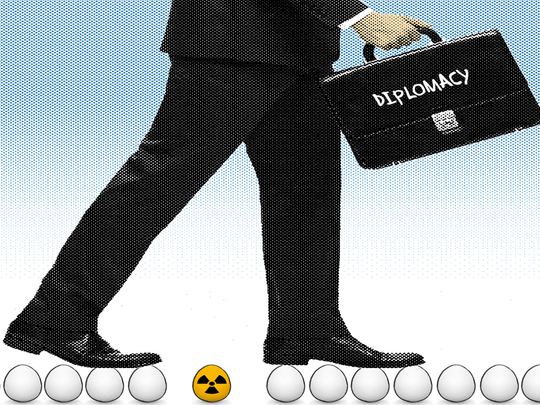
United States Vice-President Mike Pence on Friday attended the opening ceremony of the Winter Olympics in South Korea, after a three day tour of Japan. In what was his latest prominent trip as a US global ambassador, he echoed his boss US President Donald Trump’s message last week that “we have no road left” on the Korean nuclear stand-off.
At the Olympic ceremony, Pence studiously avoided Kim Yong-nam — the sister of North Korean dictator Kim Jon-un. This diplomatic snub followed the US vice-president’s discussions in Japan about how best to press Pyongyang to abandon its nuclear and missile development programmes after Trump agreed on the phone with Japanese Prime Minister Shinzo Abe last week “on the need to intensify the international maximum pressure campaign to denuclearise North Korea”.
Pence’s trip comes at a time of significant internal US administration disagreement over a pre-emptive strike against North Korea. Trump’s State of the Union address last month ratcheted up the rhetoric, noting that Pyonyang’s “reckless pursuit of nuclear missiles could soon threaten our homeland ... past experience has taught us that complacency and concessions only invite aggression and provocation. I will not repeat the mistakes of past administrations that got us into this dangerous position”. Yet, some key US military leaders — including Chairman of the Joint Chiefs-of-Staff, General John Dunford, Defence Secretary James Mattis, and Secretary of State Rex Tillerson have all reportedly expressed concern about a pre-emptive strike.
As Vice-President, Pence is a pivotal player in this debate and he tweeted last week that his visit to Asia was designed “to deliver a message that the era of strategic patience is OVER. As North Korea continues to test ballistic missiles and threaten the United States, we’ll make it clear all options are on the table”. While Pence’s exact view on a pre-emptive strike is not crystal clear, he certainly shares the belief that maximum pressure must be placed on Pyongyang to give up its nuclear and missile development programmes.
With the eyes of much of the world on Korea with the Winter Olympics, Pence had a prominent platform, and he wanted to show himself to be an effective foreign ambassador for the administration and avoid some of the raucous rhetoric that sometimes comes from Trump’s mouth. Here, he was well aware that North Korean state media had already sought to characterise his trip as war-mongering and trying to create a “confrontation theatre” at the Olympics.
Pence, therefore, sought to set the right tone with many in the region anxious about America’s next steps after the Korean Games. This concern has been fuelled by Trump’s comments last week that “We think the Olympics will go very nicely and after that, who knows?”.
Pence’s latest trip underlines his growing stature as a foreign statesman. In his big international visits in 2017, he generally showed diplomatic surefootedness, although his visit last month to the Middle East was strewn with intense controversy, following Trump’s widely criticised decision to formally recognise [occupied] Jerusalem as Israel’s capital.
Part of the reason Pence has become an increasingly key figure in this American administration’s foreign policy is that it remains unclear how much sway Tillerson and Mattis hold with Trump. This is especially the case with Tillerson and media reportage in 2017 serially speculated he may not last long in his post.
Yet, Pence assuming such a high global profile is also following a pattern whereby the last three incumbents of his job as vice president — Joe Biden, Dick Cheney, and Al Gore — all enjoyed sizeable influence in not just foreign policy, but also domestic affairs. Indeed, Cheney, who was a predominant voice in many of Bush’s big decisions, including the US-led invasion of Iraq, is widely viewed as the most powerful ever holder of the office.
Going forward, it is possible that Pence may play an even bigger role in US international policy. Here a relevant factor is that, at 70, Trump was in November 2016 the oldest person ever to win the US presidency.
This elevates the possibility that, especially if Trump wins a second term in 2020, Pence might be required to assume the presidency upon the incumbent’s unanticipated death or physical incapacity. And it is partly for this reason that Trump chose a significantly younger running mate (Pence is 58) with wide-ranging political experience who, in the nuclear age, he perceived to be capable of assuming the top job should that be necessary.
Even if Trump survives the full duration of his presidency — and is not impeached or decides to unexpectedly stand down before the end of his term — Pence could still get his hands on the top job if he and the administration are perceived to be successful in the coming years. This is because the vice-presidency has become perhaps the single best transitional office to the Oval Office in recent decades, and it is very plausible that Pence will run for the presidency himself in the future.
Indeed, since 1960, four sitting vice-presidents (Richard Nixon in 1960, Hubert Humphrey in 1968; Walter Mondale in 1984; and Gore in 2000) won their respective party’s presidential nomination, but then lost the general election. Meanwhile, two vice-presidents have been elected president (Nixon in 1968 and George H.W. Bush in 1988).
Taken overall, Pence’s Asia trip has highlighted the possibility of an even tougher US line against North Korea after the Olympics, and reinforced his role as an increasingly prominent player in international affairs. Moreover, his hosts in Asia were well aware that there is a significant chance he could become president himself in the 2020s, if not before, which means his influence may only grow on the global stage.
Andrew Hammond is an Associate at LSE IDEAS at the London School of Economics.










